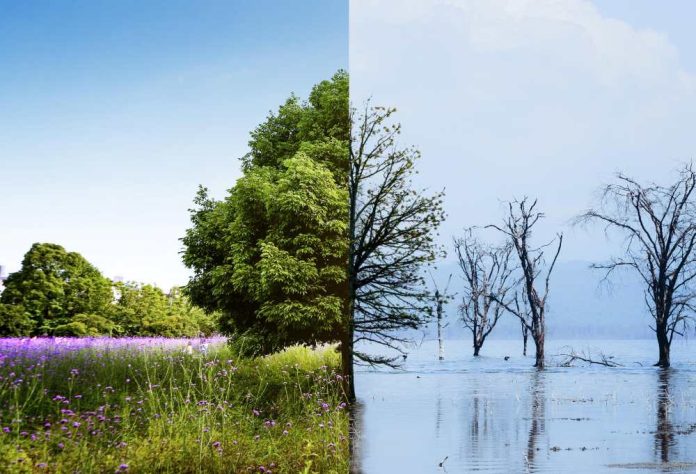Introduction
Climate change is more than an environmental problem; it is one of the greatest threats to human rights in the modern era. Rising temperatures, extreme weather, vanishing species, and climbing sea levels are already harming people’s lives and livelihoods. These impacts are not evenly spread. The poorest communities, indigenous groups, women, and children often bear the heaviest burden. This makes it clear that climate change and human rights are closely connected and that the world must come together to respond to this shared challenge.
Understanding Climate Change
In simple terms, climate change means long-term shifts in the Earth’s climate. Today it mostly refers to the steady rise in global temperatures caused by human activities like burning coal, oil and gas, cutting down forests, and operating polluting industries. Experts such as the Intergovernmental Panel on Climate Change (IPCC) warn that if we do not act quickly, the planet will soon cross the 1.5°C warming limit set by the Paris Agreement.
Some of the major effects of climate change are:
- More frequent floods, droughts, and storms.
- Melting ice caps and rising sea levels.
- Trouble with farming and food production.
- The spread of new and old diseases due to changing weather patterns.
All of these affect people’s basic rights to food, water, health, and even life itself.
Climate Change as a Human Rights Issue
Human rights are basic entitlements that belong to everyone. They include the rights to life, health, food, water, housing, and a decent standard of living. Climate change threatens each of these rights in a serious way.
Some key examples are:
- Right to Life: More heatwaves, floods, and storms take thousands of lives every year.
- Right to Health: Air pollution, unsafe water, and diseases spread more as the climate shifts.
- Right to Food and Water: Droughts and floods reduce harvests and limit access to safe drinking water.
- Right to Housing: Rising seas and spreading deserts push people out of their homes.
- Right to Development: Indigenous communities and small island nations lose land, culture, and ways of life.
Climate change makes inequalities worse, especially for those who have done the least to cause it.
International Efforts to Protect Climate and Human Rights
The world has begun to recognize that climate change and human rights go hand in hand. Some major steps are:
-
United Nations Framework Convention on Climate Change (UNFCCC) (1992): Laid the foundation for global cooperation.
-
Kyoto Protocol (1997): Made developed countries legally responsible for reducing emissions.
-
Paris Agreement (2015): Set the goal of keeping global warming well below 2°C, preferably 1.5°C.
-
UN Human Rights Council (2021): Formally recognized the right to a clean, healthy, and sustainable environment.
-
Sustainable Development Goals (SDGs): Goal 13 calls for urgent action on climate change.
These agreements aim at both mitigation (reducing emissions) and adaptation (helping people live with the impacts).
Global Inequality and Climate Justice
Climate change also exposes the gap between rich and poor nations. Developed countries are largely responsible for greenhouse gas emissions, but developing countries suffer more of the consequences. This is why the idea of climate justice is so important. It means:
- Sharing the responsibility for cutting emissions fairly.
- Providing money and technology to poorer countries to help them adapt.
- Protecting the rights of future generations to a healthy and safe planet.
At COP27 in 2022, countries agreed to create a Loss and Damage Fund to support nations most severely hit by climate disasters.
Role of Governments and Corporations
Both governments and corporations must act to tackle climate change.
-
Governments should make climate-friendly laws, reduce emissions, and protect citizens’ rights.
-
Corporations must follow environmental standards, move to sustainable business practices, and cut their carbon footprints.
If they do not act, they could be held accountable under emerging environmental and human rights laws.
Climate Refugees and Migration
Millions of people are forced to move every year because of floods, droughts, or rising seas. These people are often called “climate refugees.” Yet they are not covered by existing international refugee laws. This leaves a major gap in protection and calls for new policies and agreements to safeguard their rights.
A Human Rights-Based Approach to Climate Action
Fighting climate change fairly means weaving human rights principles into all climate policies. This includes:
-
Allowing all people, especially poor and marginalized groups, to participate in decisions.
-
Respecting dignity and rights while planning adaptation measures.
-
Combining environmental protection with social justice.
This approach ensures that no one is left behind.
The Way Forward
Seeing climate change as a human rights issue requires coordinated action from all countries. The key steps are:
- Strengthen and enforce international agreements.
- Increase climate finance and technology support for vulnerable nations.
- Recognize and protect the rights of climate refugees.
- Encourage renewable energy and sustainable lifestyles.
- Hold governments and corporations accountable for environmental damage.
The principle of “common but differentiated responsibilities” means that while every country must act, those most responsible for emissions must lead the way.
Conclusion
Climate change is not only an environmental crisis but also a major threat to human dignity and basic rights. Its effects are global but hit the weakest the hardest. The solution lies in making human rights a part of climate action—fairness, participation, and accountability. Only through global cooperation and shared responsibility can we protect both the planet and the rights of future generations.
Also Read:
Rights of undertrial prisoners in India
How To Send A Legal Notice In India


